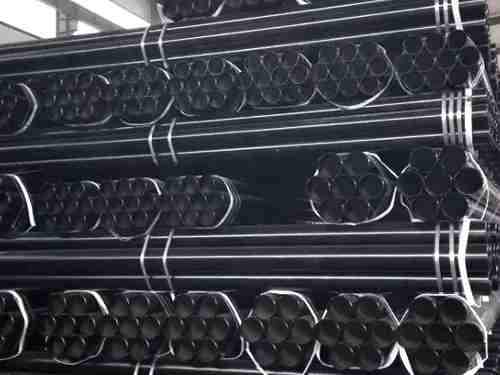Over the past few decades, significant advancements in continuous casting technology and online computer-controlled rolling automation have led to the maturation of the H-beam production process. The rolling process, from special-shaped billets to finished products, is constrained by factors such as the relatively low temperature of the rolled piece and the metal’s poor plasticity. One of the first challenges in the rolling process is to prevent lateral metal flow. This can be achieved by ensuring that the diameter ratio of the drive horizontal roller to the driven vertical roller is controlled at 3:1. Additionally, when designing the hole type and adjusting the rolling mill, it is crucial to ensure the extension of the legs and waist of the rolled piece is consistent. Any discrepancy here can negatively impact the accuracy of the finished product's dimensions and its overall appearance.
- Rolling Marks
Rolling marks on H-beams can generally be categorized into two types: periodic rolling marks and non-periodic rolling marks.
Periodic Rolling Marks: These are regularly spaced on the surface of the H-beam. The front and rear rolling marks appear at the same depth and location on the rolled piece, with the distance between them being equal to the circumference of the roller. These marks are typically caused by roll wear or the presence of iron oxide in the hole type, which leads to bulges or pits on the surface of the rolled piece.
Non-periodic Rolling Marks: These are caused by severe wear on the guide devices or mechanical collisions, such as those between rollers. This leads to scratches on the steel, which then results in grooves or missing material along the rolling direction.
- Folding
Folding is a defect similar to cracks that can be clearly identified after pickling, where a visible crack appears in the cross-section of the folded area, exposing it to the outside. Folding typically results from improper hole design or improper rolling mill adjustments. This defect is caused by the formation of ears at the hole opening due to overfilling. After rolling, these ears are pressed into the body of the rolled piece but do not weld with the body, creating a folded section. The severity of the fold depends on the height of the ears. Additionally, improper design or excessive wear of the arc between the waist and legs can cause grooves and edges on the rolled piece surface, which leads to folds.
- Waves
Waves in H-beams are of two types: waist waves and leg waves.
Waist Waves: These are washboard-shaped deformations at the waist of the H-beam. They are caused when excessive pressure on the waist leads to excessive elongation of the waist compared to the legs.
Leg Waves: These appear at the ends of the legs as crests and troughs. These waves occur when the legs elongate more than the waist during the hot rolling process.
Both types of waves damage the appearance of H-shaped steel. Waves occur due to the inconsistent elongation of various parts of the rolled piece during hot rolling. When the waist undergoes excessive compression, it elongates too much compared to the legs, leading to waist waves. Conversely, when the legs elongate too much and the waist extends too little, leg waves are generated. Another contributing factor is the improper design of the steel section, particularly the thickness ratios of the waist and legs. During the cooling process, the thinner parts (waist) cool faster than the thicker parts (legs), creating internal thermal stresses that lead to waves.
To address this issue, the hole type should be reasonably designed to allow for more uniform deformation during the initial rolling passes. In the finishing pass, efforts should be made to ensure that the waist and legs extend consistently. Additionally, to reduce temperature differences, the legs of the rolled piece can be sprayed to accelerate the cooling of the waist or vertical cooling operations can be adopted.
- Rounded Corners at the Leg Ends
Rounded corners at the leg ends of H-beams refer to unevenness between the two sides of the leg and the end, where the contour lacks the standard material thickness. There are several reasons for this defect:
Worn Cutting Hole of the Blanking Machine: If the blanking machine’s cutting hole is worn, it can result in thicker leg parts. When entering the next hole, the wedge effect prevents proper processing of the leg ends.
Mismatch in Speed Between the Frame and Edge Rolling Machine: If the frame and the edge rolling machine do not synchronize in speed, excessive tension causes steel pulling, preventing the leg ends from reaching the required height, leading to rounded corners.
Web Plate Misalignment: If the web plate on the side is offset during rolling, it causes the rolled piece to deviate from the symmetric axis of the hole, leading to defects at the leg ends.
- Asymmetric Leg Length
Asymmetric leg lengths in H-beams can occur in two ways:
Upper Leg Longer than the Lower Leg
One Leg Longer in the Upper Position and the Other in the Lower Position
This defect is often accompanied by uneven leg thickness, with the longer leg being slightly thinner and the shorter leg thicker. There are several causes of leg length asymmetry:
Billet Opening Process: If the billet is misaligned with the hole type during deep cutting, a cut deviation can result, making one leg thicker and the other thinner. Though the reduction is ideally distributed in subsequent passes, correcting this asymmetry is difficult, leading to the formation of asymmetric leg lengths.
Axial Misalignment of the Rolling Mill: If there is horizontal roll bundle misalignment, this causes uneven lateral pressure on the legs, resulting in leg length asymmetry, with the defect distributed diagonally across the legs.

 English
English Español
Español











